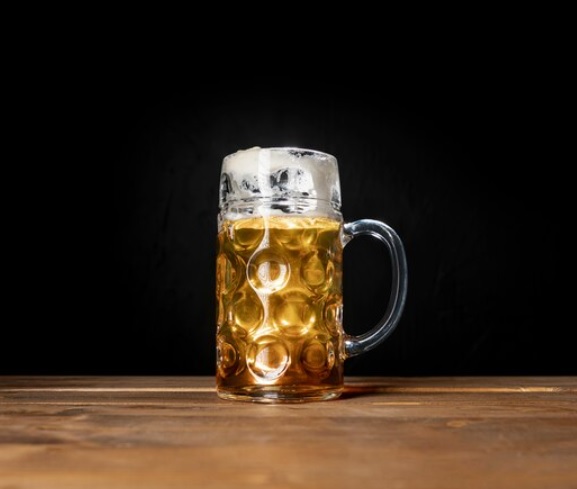How To Tell Beer Is Bad?
Yeah, beer can go bad – but how do you know if your beer is bad? How to tell beer is bad?
Knowing if your beer is bad is kinda important… No one wants to take a sip of what should be a refreshing beverage only to be met with off-putting flavors or unpleasant aromas. Quickly identifying bad beer lets you make informed choices, avoiding disappointment and potentially saving money.
Fortunately, a few simple observations can help you determine if your beer is up to par. By paying attention to visual cues, checking for unusual aromas, and being mindful of taste, you can swiftly assess the quality of your beer and decide whether it’s worth savoring or better left untouched.

Signs of Bad Beer
A. The Visual Signs
Visual indicators play a pivotal role in determining the quality of beer, offering valuable insights into its freshness and overall condition. Observing the appearance of beer can provide immediate clues about its potential palatability.
- Unusual Colors:
- The color of beer is a key characteristic that varies across different styles. However, if you notice unexpected hues, such as an overly dark or light color compared to the beer style norms, it could indicate quality issues. Discoloration may suggest problems with ingredients or the brewing process.
- Cloudiness:
- While some beer styles are intentionally hazy, excessive cloudiness in traditionally clear styles might signal issues. Cloudiness could result from suspended yeast, proteins, or other particles, impacting the beer’s texture and taste.
- Presence of Floating Particles:
- Visible particles floating in the beer are a clear red flag. These particles could be remnants of ingredients that haven’t settled properly or, worse, signs of contamination. A pristine beer should be free of any visible debris.
- Sediment:
- Sediment settling at the bottom of a bottle or glass is often normal in certain styles, particularly unfiltered or bottle-conditioned beers. However, an excessive amount of sediment or unexpected sediment in a filtered beer may indicate problems with the brewing or packaging process.
- Abnormal Foam:
- The foam, or head, on a beer can reveal a lot about its quality. A beer should generally produce a stable and appropriate foam. If the foam dissipates rapidly or has irregularities like large bubbles, it might suggest issues with carbonation or brewing practices.
- Lacing:
- Lacing refers to the pattern of foam left on the glass as you drink. While some lacing is normal, excessive or uneven lacing might indicate problems with the beer’s texture and mouthfeel, potentially linked to issues with ingredients or brewing conditions.
- Carbonation Level:
- The right amount of carbonation is vital for a beer’s overall enjoyment. Overly fizzy or completely flat beer can be indicative of problems during the brewing or packaging stages. Checking for the appropriate level of carbonation ensures a more satisfying drinking experience.
While some variations may be intentional, any drastic deviations from the expected appearance for a given style could be indicative of problems in the brewing or handling process.

B. Aromatic Signs
A beer’s aroma is a powerful indicator of its quality, and unpleasant smells can instantly signal that something may be amiss. Here’s a closer look at some key aroma indicators of bad beer:
- Skunkiness:
- One of the most universally recognized off-putting aromas in beer is skunkiness. This odor is often likened to the scent of a skunk and is typically associated with beers that have been exposed to light, especially those in clear or green bottles. The interaction of light with hops can result in a chemical reaction, producing compounds responsible for the skunky smell. A properly stored and packaged beer should not exhibit this characteristic.
- Sour Notes:
- While some beer styles intentionally embrace sourness, unexpected sour notes in beers not designed to be sour could indicate contamination. Undesirable bacteria or wild yeast strains may have infiltrated the brewing process, leading to off-flavors that are distinctly sour and unpleasant.
- Diactyl (Buttery Flavor):
- Diacetyl is a compound that can impart a buttery or butterscotch-like aroma and flavor to beer. In controlled amounts, diacetyl can contribute to the complexity of certain styles, but an excess of it is considered a flaw. If you detect a strong buttery aroma, it may suggest issues with fermentation or yeast health.
- Oxidation:
- Oxidation can produce stale, cardboard-like aromas in beer. When beer is exposed to oxygen, especially during the brewing, packaging, or storage processes, it can lead to the breakdown of compounds, resulting in off-flavors. A well-preserved beer should have a fresh and inviting aroma.
- Infected Aromas:
- Unwanted microbial contamination can introduce a variety of strange and off-putting aromas. These can range from musty or moldy scents to medicinal or band-aid-like odors. If the beer’s aroma reminds you of anything other than the intended ingredients, it’s a clear sign of potential issues.
- Malty or Hoppy Overwhelm:
- While maltiness and hoppiness are key components in many beer styles, an overwhelming dominance of either could indicate imbalance or mistakes in the brewing process. A well-crafted beer should showcase a harmonious blend of malt and hop aromas, enhancing the overall experience.
- Funky or Unusual Aromas:
- Trust your instincts when it comes to identifying any funky or peculiar smells. If the beer’s aroma deviates significantly from what is expected based on its style, it may suggest defects or contamination.
In conclusion, a beer’s aroma is a complex interplay of various compounds, and off-putting smells can be indicative of problems in the brewing and handling processes. Developing a keen sense of smell and being attuned to the expected aromas for different beer styles will enhance your ability to quickly identify and appreciate well-crafted beers while avoiding those with undesirable attributes.

C. Weird Taste
Tasting a beer provides the most direct and immediate assessment of its quality, and various taste characteristics can reveal whether the beer is well-crafted or if it has notable flaws. Here’s a breakdown of taste signs that may indicate issues with beer:
- Excessive Bitterness:
- While bitterness is a defining characteristic in many beer styles, an overpowering bitterness that lingers excessively on the palate may indicate an imbalance. A well-brewed beer should have a bitterness that complements the other flavors, rather than dominating the overall taste experience.
- Astringency:
- Astringency results from tannins, which can be derived from malt husks, grains, or hops. An excessively astringent beer can impart a dry, puckering sensation in the mouth, similar to the feeling you get from oversteeped tea. Astringency is often considered an off-flavor, and it can distract from the beer’s intended flavors.
- Unpleasant Aftertaste:
- A lingering aftertaste that is undesirable or different from the intended flavor profile is a clear sign of potential issues. This could include metallic or medicinal notes, and it may indicate problems with the brewing process, ingredients, or overall beer quality.
- Off-Flavors:
- Various off-flavors can manifest in beer, indicating specific problems in the brewing or fermentation process. Common off-flavors include diacetyl (buttery), acetaldehyde (green apple), isoamyl acetate (banana), and 4-vinyl guaiacol (clove). Recognizing these off-flavors requires a trained palate, but their presence can significantly impact the beer’s taste.
- Infection:
- If a beer tastes sour or exhibits unexpected funky flavors, it may be a sign of bacterial or wild yeast contamination. Infections can introduce flavors that range from sour and tart to musty or barnyard-like, depending on the specific microbes involved.
- Flatness or Overcarbonation:
- The right level of carbonation is crucial for the mouthfeel of a beer. Flat beer lacks the effervescence that can enhance the overall experience, while overcarbonated beer can be excessively fizzy and may even cause a burning sensation. Both situations can detract from the intended taste.
- Maltiness and Hop Balance:
- Depending on the beer style, a balance between malt sweetness and hop bitterness is often desired. If one flavor overwhelms the other or if there’s a lack of harmony between the malt and hop characteristics, it could signal brewing imbalances.
- Mouthfeel Issues:
- Problems with mouthfeel, such as excessive thickness (viscosity) or a watery consistency, can affect the overall drinking experience. A beer’s mouthfeel should complement its style, providing a satisfying texture that enhances the flavors.
In summary, assessing the taste of a beer involves considering various factors, including bitterness, astringency, aftertaste, and the presence of off-flavors. A well-crafted beer should showcase a balanced and harmonious combination of flavors that align with the intended style. Paying attention to these taste indicators allows you to quickly identify and appreciate high-quality beer while avoiding those with noticeable flaws.

Packaging and Storage Problems
When it comes to enjoying a great beer, the condition in which it’s packaged and stored plays a crucial role. Here’s a quick guide to ensure you’re sipping on the best:
1. Packaging Integrity:
- Why it matters: A well-sealed package preserves the beer’s flavors and protects it from external factors. Check for any signs of damage, leaks, or compromised seals. A intact package ensures that the beer inside hasn’t been exposed to air or contaminants.
2. Expiration Dates and Freshness Indicators:
- Why they matter: Breweries often stamp expiration dates or provide freshness indicators on their products. Respect these dates. Freshness impacts flavor, and an expired beer might not deliver the taste the brewer intended. Look for clear labels indicating when the beer is at its best.
3. Proper Storage Conditions:
- Why it matters: Beer is sensitive to its environment. Exposure to heat, light, and temperature fluctuations can degrade its quality. Store beer in a cool, dark place, away from direct sunlight and temperature extremes. Don’t freeze beer! Follow any specific storage recommendations from the brewery to maintain optimal freshness.
Remember, a little attention to the package and storage conditions can go a long way in ensuring that your beer-drinking experience is nothing short of excellent.

Beer Styles and Expectations
Each beer style is a unique canvas of flavors, carefully crafted by brewers to deliver a distinct taste experience. Here’s how to identify intentional flavors and distinguish them from unintentional ones:
1. Understanding Beer Styles:
- Why it matters: Before diving in, familiarize yourself with the typical flavor profile of the beer style you’re sipping. Whether it’s the hop-forward bitterness of an IPA, the malty richness of a stout, or the fruity notes of a Belgian ale, knowing the expected flavors is key.
2. Aromas and Tastes That Align:
- What to look for: Intentional flavors should align with the style’s characteristics. If you’re enjoying a classic pilsner, the hop aroma might be crisp and floral, not skunky. In a chocolate stout, the rich, roasted malt flavors should shine, without unexpected sour or astringent notes.
3. Balance is Key:
- Why it matters: Well-crafted beers achieve a harmonious balance between different flavor components. For example, in a sour beer, the acidity should be present but not overwhelming. A well-balanced beer allows each flavor to contribute to the overall enjoyment.
Distinguishing Unintentional Flavors:
1. Off-putting Aromas:
- What to note: If the aroma deviates significantly from the expected scent of the style, it could be a sign of unintentional flavors. For instance, a lager shouldn’t smell like vinegar, and a wheat beer shouldn’t have a strong metallic note.
2. Unusual Tastes:
- What to look for: Take note of any tastes that seem out of place. If a beer meant to be fruity has an overpowering metallic flavor or if a pale ale exhibits excessive sourness, it’s likely an unintentional flaw.
3. Lingering Off-Flavors:
- Why it matters: After you’ve swallowed, pay attention to lingering tastes. Lingering off-flavors, such as a persistent buttery aftertaste, often indicate brewing issues rather than intentional choices.
In summary, recognizing intentional flavors involves understanding the characteristics of different beer styles and identifying the subtle nuances that make each style unique. Distinguishing intentional from unintentional flavors is about aligning your expectations with the style guidelines and being attuned to any off-notes that might detract from the intended experience.

Preventive Measures to Avoid Bad Beer
Ensuring a delightful beer-drinking experience goes beyond the moment of purchase. Here are three straightforward preventive measures to enhance your beer enjoyment:
1. Buy Beer from Reputable Sellers/Sources:
- Why it matters: The journey of your beer starts at the point of purchase. Choose reliable and reputable sellers or establishments known for maintaining quality. Whether it’s a local brewery, a trusted bottle shop, or a well-regarded pub, selecting the right source significantly increases the likelihood of obtaining a well-crafted and fresh beer.
2. Check for Proper Storage Conditions:
- What to look for: Investigate the storage conditions at the point of sale. Ensure that the beer is stored in a cool and dark environment, away from direct sunlight and temperature extremes. Ask questions if needed – a well-managed storage environment helps preserve the beer’s integrity, preventing issues like skunkiness or premature aging.
3. Educate Yourself on Beer Styles:
- Why it matters: Understanding the wide array of beer styles empowers you to set realistic expectations. Familiarize yourself with the typical flavors, aromas, and appearances associated with different styles. Knowing what to anticipate makes it easier to identify intentional characteristics and recognize potential flaws.
Quick Tips for Education:
- Read Beer Descriptions: Before trying a new beer, read the brewery’s description. It often provides insights into the beer’s style, ingredients, and intended flavors.
- Attend Tastings or Beer Events: Participate in tastings or beer events to broaden your palate and deepen your understanding of diverse beer styles.
- Join Beer Communities: Online or local beer communities offer valuable insights and recommendations. Engaging with fellow enthusiasts can enhance your knowledge and appreciation.
Wrapping It Up
From visual cues to aromas and tastes, being aware of signs that something might be off ensures you’re always sipping on ONLY the good stuff. Stick to reputable sources, check the packaging, and store your beer right. Educate yourself on styles to set realistic expectations. Simple steps that make every beer moment a quality one. Cheers to enjoying beers that live up to the hype!

I am a young architect with a passion that goes beyond blueprints… it’s beer! undertherosebrewing.com is more than just a blog, it’s a manifestation of my lifelong dream to explore, read, and learn everything about beer. Join the blog on this unfiltered and genuine adventure into the heart of beer culture. Cheers!






